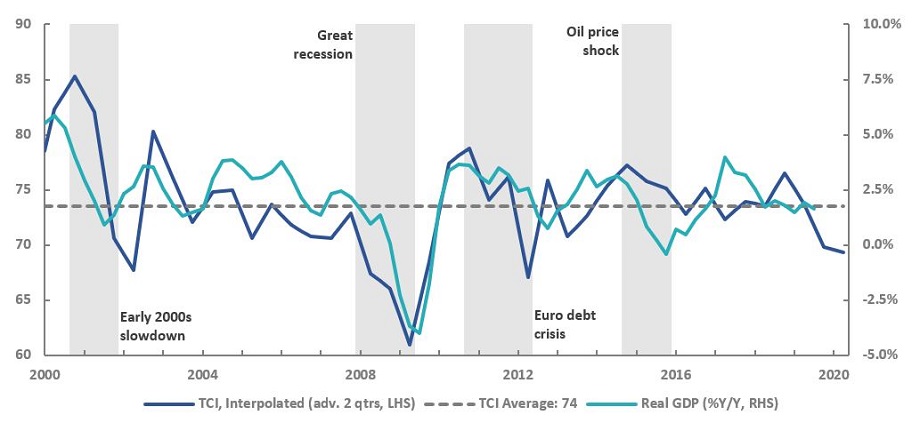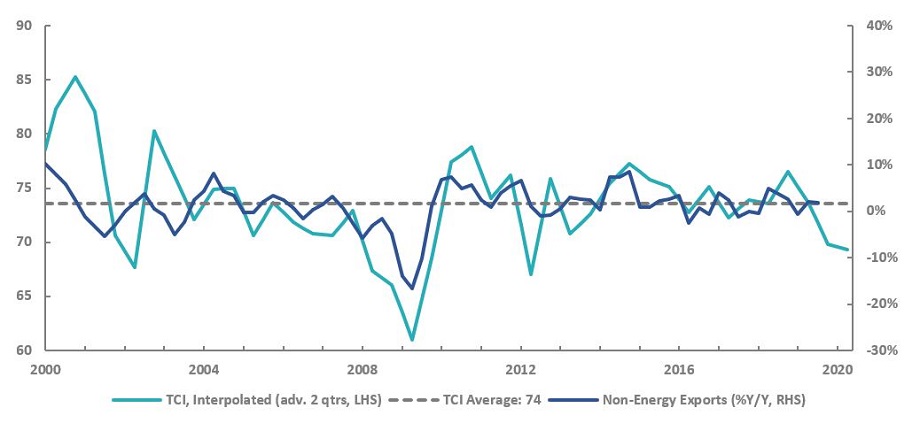Canadian exporters have a strong financial interest in correctly anticipating future demand for their goods and services. That begs the question: Are their collective expectations helpful in predicting the nation’s future exports? To answer that, the EDC Economics team constructed a simple statistical model and found that our Trade Confidence Index (TCI) can help predict future Canadian exports.
For more than 20 years, EDC has surveyed 1,000 Canadian companies twice a year to assess their confidence in global trade. These companies are either exporting or planning to export in the next two years. The survey asks businesses for their outlooks on domestic and international sales, economic conditions in Canada and across the world, and global business opportunities. The answers to these questions provide EDC with a unique insight into Canadian trade, enabling us to respond quickly to emerging trends.
In our 2019 year-end survey, the TCI fell to its lowest level in almost a decade. The decline in confidence likely reflected the intensifying United States-China trade dispute and a slowdown in the global economy. We found that protectionism remained a persistent concern and a key challenge for Canadian exporters. These findings suggest that Canadian exporters keep up with global developments and respond to them accordingly. In fact, when we chart the TCI against Canadian output growth, we can see that the TCI tracks overall economic activity.

Sources: EDC Economics; Haver Analytics
In Chart 1, we’ve shifted the TCI forward by two quarters to show that it does a pretty good job of forecasting Canadian gross domestic product (GDP). The TCI is focused on Canadian trade, which is why it diverges away from GDP at certain points. For example, exporters were quite worried about the European debt crisis, which could have impacted European demand for Canadian goods. We saw a sharp drop in the TCI around this time, but it didn’t have a strong impact on Canadian GDP.
On the other hand, when oil prices collapsed between 2014 and 2016, Canadian GDP growth took a hit. But exporters weren’t as worried, and this reflects the fact that our survey is sent out to a representative sample of exporters across various industries. Broadly, the demand for Canadian goods, outside of oil, wasn’t impacted by the price collapse.

Sources: EDC Economics; Haver Analytics
In Chart 2, we’ve overlaid the TCI on Canadian non-energy exports growth—the year-on-year percentage change in Canadian exports, excluding exports of energy products. The TCI tracks export growth well, with a correlation coefficient of 0.64. This means there’s a positive relationship between the TCI and future export growth. Therefore, Canadian exporters are quite good at anticipating future demand for their products.
EDC Economics constructed a simple statistical model of future export growth. When we added the TCI to the model, we found a significant improvement in the model’s accuracy. We used the TCI to predict the Canadian goods, services, and non-energy exports. In each case, including the TCI significantly improved the model’s performance. See our research report for details on our methodology and our complete results.
This work suggests that Canadian exporters should keep a close eye on the TCI. It can let them know how other Canadian companies are feeling, and what to expect in the future. Most importantly, it can help them anticipate future demand for their goods and services, so that they can make better business decisions.






